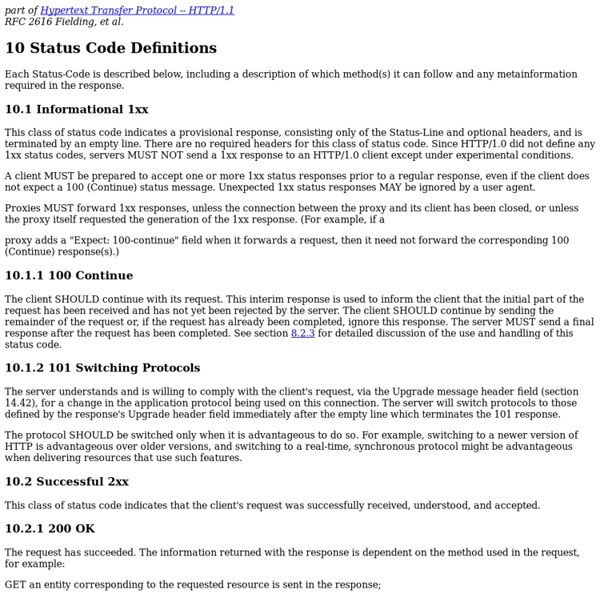HTTP/1.1: Header Field Definitions
This section defines the syntax and semantics of all standard HTTP/1.1 header fields. For entity-header fields, both sender and recipient refer to either the client or the server, depending on who sends and who receives the entity. 14.1 Accept The Accept request-header field can be used to specify certain media types which are acceptable for the response.
Securing Internet Information Services 6.0
Updated : July 21, 2006 On This Page Introduction Before You Begin Reducing the Attack Surface of the Web Server Configuring Accounts Configuring Security for Files and Directories Securing Web Sites and Virtual Directories Configuring Secure Sockets Layer on Your Web Server Related Information Introduction Web servers are frequent targets for various types of security attacks.
Starting Front-End Projects — So Coded Conference - 19.09.2013
Repetition from project to project Same tasks to set up development and deployment Teams need consistency Use a framework or boilerplateFind differences to your workflow/preferencesApply changes you needStart coding
Hypermedia
Hypermedia, an extension of the term hypertext, is a nonlinear medium of information which includes graphics, audio, video, plain text and hyperlinks. This contrasts with the broader term multimedia, which may include non-interactive linear presentations as well as hypermedia. It is also related to the field of electronic literature.
Configure Linux As Bastion Host
What is bastion host? How do I configure bastion host under Linux? How do I create a firewall for a bastion host under any Linux distribution? A bastion host is high risk host on your network. It can be a dedicated Linux running netfilter or OpenBSD box running PF or a Cisco PIX device.
Software Package Data Exchange (SPDX)
The SPDX License List is a list of commonly found licenses and exceptions used in free and open source and other collaborative software or documentation. The purpose of the SPDX License List is to enable easy and efficient identification of such licenses and exceptions in an SPDX document, in source files or elsewhere. The SPDX License List includes a standardized short identifier, full name, vetted license text including matching guidelines markup as appropriate, and a canonical permanent URL for each license and exception. License Exceptions: The list of commonly found exceptions to free and open source licenses, which can be used with the License Expression operator, "WITH" to create a license with an exception. Master Files: The HTML pages you see here are generated from the master files for the SPDX License List. Data Files: Machine readable files describing all of the licenses and license exceptions.
Remote procedure call
In computer science, a remote procedure call (RPC) is an inter-process communication that allows a computer program to cause a subroutine or procedure to execute in another address space (commonly on another computer on a shared network) without the programmer explicitly coding the details for this remote interaction.[1] That is, the programmer writes essentially the same code whether the subroutine is local to the executing program, or remote. When the software in question uses object-oriented principles, RPC is called remote invocation or remote method invocation. Many different (often incompatible) technologies have been used to implement the concept. History and origins[edit] Message passing[edit] An RPC is initiated by the client, which sends a request message to a known remote server to execute a specified procedure with supplied parameters.
Bastion host
Background[edit] ...a system identified by the firewall administrator as a critical strong point in the network's security. Generally, bastion hosts will have some degree of extra attention paid to their security, may undergo regular audits, and may have modified software.[2] Definition[edit] It is a system identified by firewall administrator as critical strong point in network security. A bastion host is a computer that is fully exposed to attack.
How to Create a REST Protocol
December 01, 2004 Note: In this inaugural article of Joe Gregorio's new column, The Restful Web, he explains how to use the REST architectural style to create an application protocol with web-like properties. Future columns will offer additional REST-based applications and analyses. — Editor If you follow web services, then you may have heard of REST. REST is an architectural style that can be used to guide the construction of web services.
Security Auditing
Updated: January 25, 2010 Applies To: Windows Server 2008, Windows Server 2008 R2 This navigation topic for the IT professional describes the documentation available to plan, implement, and monitor events by using features found in Windows Security Auditing.
Improve Your Debugging Skills with Chrome DevTools
In this post we cover best practices and tips for using Chrome Dev Tools, which will help you solve your web application development struggles more easily. Have you ever had trouble with incorrectly executed JavaScript? Have you ever struggled with fine-tuning the CSS of the elements on your web page? Are you annoyed every time you test your web page on multiple different mobile devices? If the answer to at least one of the questions is "yes," then this blog post is meant for you.



